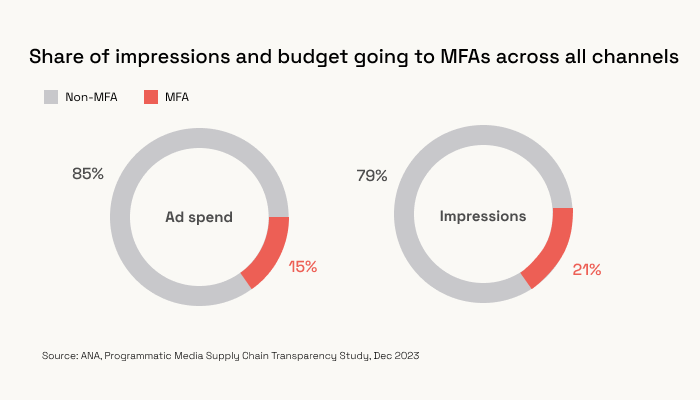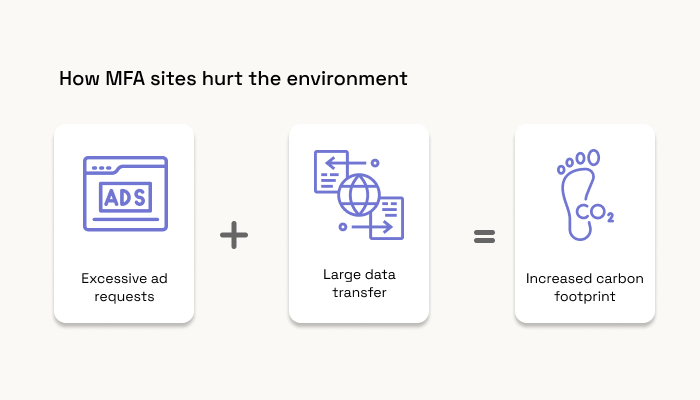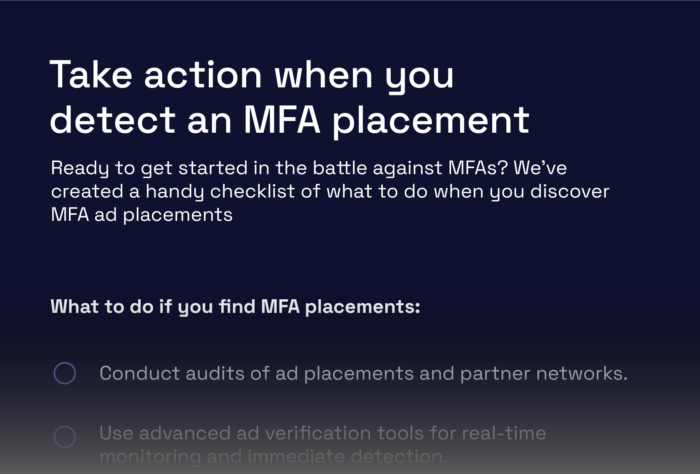As the name suggests, made-for-advertising (MFA) sites exist for one single purpose: to simultaneously buy and sell ad inventory. These domains are associated with low-quality ad inventory, poor user experience, and higher levels of invalid traffic (IVT). As a result, MFA sites waste both ad budgets and our planet’s natural resources.
The good news is that advertisers can take measures to protect themselves from MFA sites, and by doing so, these sites – and their carbon footprints — will lessen in prevalence and size.
What are MFA sites?
Made-for-advertising (MFA) websites are sites designed to display as many advertisements as possible. Sometimes called “made-for-arbitrage” websites, MFA often feature low-quality content and use tactics such as pop-ups, auto-play videos, or intrusive ads to maximize ad revenue by charging advertisers for impressions and engagement. (Let’s be honest, though — any “engagement” is probably someone desperately trying to mute auto-play videos and escape the overwhelming popups!)
Where does MFA happen?
MFA is primarily an issue on web, where it accounts for nearly 10% of all ad spend. While CTV and in-app inventory is not totally immune to MFA tactics, they are considerably safer.
And not only is in-app advertising much more resistant to MFA — both the share of unique apps classified as MFA and the mobile ad spend going to these apps is on the decline. According to Pixalate, mobile ad spend going to apps flagged as MFA decreased 29% from January to March 2024.
Impact of MFA sites for brands
It is clear that MFA sites are harmful to advertisers. Not only are the sites low-quality, they also produce high levels of IVT, which includes ad fraud. Therefore, they pose financial, reputational, and regulatory risks to advertisers. However, the damage can go even further than that — MFA sites also produce unnecessary carbon waste, undermining the efforts towards sustainability in which companies like Verve invest.
Less effective campaigns
MFA content funnels ad spend to low-value websites, leading to considerable budget waste. According to the ANA, MFA sites accounted for 21% of ad impressions across all channels in 2023. And the 15% of total ad spend that went to these sites amounted to a total of $10 billion.
Luckily, advertisers that invest their budgets in mobile in-app and CTV are not as at-risk to these sites; however, they are also not immune.
Endangered brand safety
While some traffic from MFA sites is fraudulent, much of it does originate from genuine human interaction. People are often driven to these sites via paid avenues like social media and content recommendation platforms. When a brand’s ads are then placed amid the undesirable content, the negative user experiences within the MFA site can harm that brand’s reputation.
Impact of MFA sites on the environment
The environmental impact of the digital advertising industry shouldn’t be underestimated. It’s why supply chain optimization (SPO) is a hot topic as companies take increased interest in cleaning up the supply path, eliminate unnecessary bids, and reduce intermediaries. Beyond just making the process more efficient, SPO also has the immense benefit of lowering carbon emissions. A study by Ebiquity and Scope3 found that carbon waste was 26% higher on MFA sites than non-MFA sites. But considering the fact that these sites offer no value to consumers, the entirety of their carbon footprint is a waste of resources.
MFA sites are some of the worst polluters in the digital advertising industry, making it critical for environmentally-conscious brands to exclude them from their advertising strategy.
How to protect your brand
The reasons for wanting to ensure that your ads do not appear on these sites are clear. And luckily, there are steps you can take to protect your brand and ensure that you do not contribute to the carbon footprint of MFA sites.
Learn to identify an MFA site
Everyone in the digital advertising industry needs to be aware of these websites and know how to identify them. Here are the most common attributes of MFA sites:
- Low dwell time: Suggest users encounter obstacles like excessive ads.
- High bounce rates: Indicate users aren’t finding what they expected.
- Limited ad interaction: Suggests users aren’t engaged.
- Ad refresh rate: More ads displayed per minute indicates a poor user experience.
- Ad density: A high volume of placement IDs per minute can mean low-quality inventory.
- Traffic source: Traffic from social and paid sources can indicate MFA.
Create a strategy to avoid MFAs
The most effective method for avoiding MFA sites is to partner with reputable ad tech firms (like Verve 😉). Supply partners should have brand safety measures in place to flag and block these sites. Since mobile in-app and CTV have much lower rates of MFAs than the web, focusing budgets on these channels is also a smart way to steer clear of such sites.
Advertisers can also monitor their performance metrics to identify MFA sites. Metrics such as click-through rates, conversion rates, time spent on site, and user interaction often make it clear when your ad has been shown on an MFA site. Especially by focusing on attention metrics and prioritizing ad buys based on engagement, rather than viewability, you can ensure that your ads are being seen by the right audience in the right context.
Take action when you detect an MFA placement
Ready to get started in the battle against MFAs? We’ve created a handy checklist of what to do when you discover MFA ad placements. Click on the image below to download:











